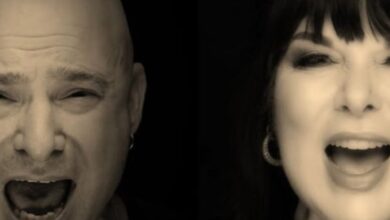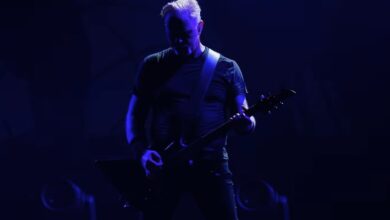Laura Lace Captivates Audiences with a Powerful and Unforgettable Rendition of Jerry C’s “Canon Rock”
When she first began uploading performances to the internet in 2008, Latvian guitarist Laura Lace quickly emerged as a rising force among modern musicians. Born and raised in Riga, she didn’t rely on flashy production or self-promotion; instead, she steadily cultivated an audience through honest musicianship. Her rock covers and instrumental compositions displayed not just her technical precision but also her emotional depth, gradually building her online presence. Over the years, her YouTube channel grew to more than 205,000 subscribers, and her TikTok videos frequently went viral. Her reach now extends far beyond Latvia, uniting lifelong rock enthusiasts with a new generation discovering the thrill of guitar music for the first time.
What sets Laura apart is her graceful balance between accessibility and enigma. She allows her guitar to speak for her, rarely revealing personal details beyond brief glimpses from practice sessions or local concerts. Fans find that mystery compelling—it makes every performance an authentic statement of art rather than a fragment of celebrity culture. Her approach strips away distraction, leaving only the connection between artist and instrument. Each upload becomes a pure moment of sound and sincerity, drawing thousands of returning listeners who wait eagerly for the next glimpse of her musical world.
The turning point arrived in 2016 with a video that forever changed her artistic path: an extraordinary performance of “Canon Rock.” The song itself occupies a special place in guitar lore. Originally composed as Pachelbel’s “Canon in D,” it was reimagined by guitarist Jerry C into a virtuosic rock showcase, combining classical precision with contemporary flair. Its intricate fingerwork, rapid scales, and shifting dynamics make it both a challenge and a rite of passage for serious players. To perform it well means fusing technical mastery with emotional conviction—a balance few can achieve.
Laura’s version didn’t merely repeat Jerry C’s arrangement—it expanded upon it. Her interpretation radiated elegance and confidence, merging classical phrasing with the grit of modern rock. Each phrase carried deliberate emotion, every bend and vibrato revealing her individuality. Instead of imitation, she created reinvention: a new expression within an already iconic piece. Listeners immediately recognized her unique voice, noting how her delicate control gave “Canon Rock” renewed vitality. Many would later declare her performance the definitive interpretation of the song.
What followed defied all expectations. The video quickly traveled across social platforms, soaring to the top of YouTube’s search results for “Canon Rock.” Within months, it accumulated tens of millions of views, ultimately surpassing 149 million and continuing to climb. The viral momentum came not from marketing but from pure astonishment—viewers around the world sharing what they believed to be one of the most impressive displays of young talent online. Musicians praised her tone and phrasing; casual fans simply marveled that such effortless perfection could be real. In a digital sea of fleeting trends, her authenticity cut through with rare force.
The story behind that global success was far more modest. Latvian guitar teacher Victor Evdokimov, dedicated to guiding young artists, had organized a small recital for his students. His goal was simple: to give them confidence performing live. Among the performers was Laura, alongside two guitarists and a drummer, unaware that the evening would one day be legendary. Filmed casually beneath warm stage lights, their performance captured genuine emotion and camaraderie rather than spectacle. It was the essence of music education—growth through shared expression, not fame. No one present could have imagined how widely that energy would one day resonate.
Everything about that evening reflected sincerity. The audience was intimate, the equipment minimal, yet the sound carried an undeniable power. When Laura took her position, there was no sense of pretense—only focus and joy. Her teacher’s encouragement, the camaraderie among peers, and the spontaneity of performing for a local crowd created the conditions for something timeless. That human simplicity became the secret ingredient that would later charm millions online. The performance’s global impact was born from an unfiltered moment of passion in a local community hall.
The performance began gently, reflecting Pachelbel’s original serenity before erupting into explosive rock energy. The contrast was mesmerizing—soft melodic lines transformed into blazing electric harmonies that filled the room. Laura’s guitar tone balanced brightness and precision, while her bandmates built rhythmic tension beneath her leads. The fusion of classical discipline and modern aggression created a sonic narrative that transcended genre. It wasn’t simply a performance; it was an act of translation, bridging centuries through sound, turning reverence into adrenaline without losing grace.
Years later, viewers still marvel at the near-perfect execution. Her fingers move across the fretboard like choreography, fluid and intentional, each note struck with clarity and control. Behind that precision lies countless hours of repetition and refinement, yet the final delivery feels effortless. She plays with composure, smiling occasionally as if to remind herself that even mastery can be joyful. It’s not only speed that impresses—it’s her ability to inject warmth and narrative into every run, turning technique into storytelling.
Her tone reveals just how thoughtful her musicianship is. Instead of hiding behind distortion, she chooses transparency—each frequency crisp and articulate. The resulting sound honors the piece’s baroque lineage while igniting it with modern drive. Her tone glows with both delicacy and authority, capturing the dual identity of the piece: classical grace meeting rock rebellion. With the drummer and rhythm guitar anchoring her phrases, the ensemble crafts an atmosphere that feels at once intimate and monumental, inviting audiences to lose themselves completely in the performance.
Reactions online reflected that universal admiration. Within days, thousands of comments appeared in dozens of languages, celebrating her technique and stage presence. Seasoned guitarists dissected her phrasing with respect, while casual listeners described the experience as exhilarating. The video’s engagement grew exponentially, surpassing 900,000 likes and continuing to climb. It wasn’t just viral popularity—it was validation from a community that recognized genuine talent. Every replay reaffirmed her as an artist capable of blending discipline, artistry, and emotion in perfect harmony.
Beyond its numbers, the success carried cultural resonance. It highlighted how classical traditions can thrive in digital spaces when reimagined through sincerity. Laura’s “Canon Rock” became a symbol of music’s universality: a Latvian musician interpreting a Taiwanese arrangement of a German baroque composition, and in doing so, reaching hearts across continents. It’s proof that creativity needs no translation, that art born in one corner of the world can belong to everyone. Her performance turned a student recital into an enduring bridge across generations and geographies.
Today, that video stands as both a milestone and a metaphor. It shows how talent nurtured with care can find its audience naturally, even in an era dominated by algorithms. For aspiring guitarists, Laura’s journey serves as a roadmap—proof that excellence, humility, and passion still resonate louder than marketing. Her “Canon Rock” continues to inspire new musicians to pick up the guitar, not to chase fame but to feel that same connection between effort and art, discipline and delight.
More than a viral clip, Laura Lace’s moment in the spotlight demonstrates the transformative power of mentorship and opportunity. Her teacher’s belief and her own dedication converged in a single performance that captured the imagination of millions. It’s a timeless story of preparation meeting fate—how one evening in Riga, recorded almost by chance, became a permanent chapter in the global language of guitar. In every replay, you can still sense the spark that started it all: the simple, unstoppable joy of music shared freely with the world.





